Abstract
ONE of the simplest questions that can be asked about how ions cross biological membranes is whether or not they do so independently of one another. That is, is the probability of movement of an ion unaffected by the presence of other ions? In particular, with independent movement, the efflux of an ion should not be a function of the external concentration of that ion. Using long-lasting depolarisations, Hodgkin and Keynes demonstrated1 non-independent movement of K+ ions across the membrane of Sepia axons. Since the Na channel responsible for initiation of the action potential inactivates very rapidly on depolarisation, potassium ions were probably not moving through this pathway—even though the channel is permeable to them as well as to Na+ ions. But since the K channels (partly responsible for termination of the action potential) also inactivate on prolonged depolarisation2, the K efflux measured by Hodgkin and Keynes was presumably mainly through inactivated K channels and the so-called ‘leakage pathway’. We report here on experiments that demonstrate non-independent ion movement through the activated K channel of the giant axon of Loligo pealei, using tetrodotoxin to block the Na channels, and short-step depolarisations to minimise K-channel inactivation.
This is a preview of subscription content, access via your institution
Access options
Subscribe to this journal
Receive 51 print issues and online access
$199.00 per year
only $3.90 per issue
Buy this article
- Purchase on Springer Link
- Instant access to full article PDF
Prices may be subject to local taxes which are calculated during checkout
Similar content being viewed by others
References
Hodgkin, A. L. & Keynes, R. D. J. Physiol., Lond. 128, 61–88 (1955).
Ehrenstein, G. & Gilbert, D. L. Biophys. J. 6, 533–566 (1966).
Begenisich, T. & Lynch, C. J. gen. Physiol. 63, 675–689 (1974).
Caldwell, P. C. & Keynes, R. D. J. physiol., Lond. 154, 177–189 (1974).
Brinley, F. J., Jr & Mullins, L. J. J. Neurophysiol. 28, 526–544 (1965).
Meves, H. & Pichon, Y. J. Physiol., Lond. 251, 60–62P (1975).
Yeh, J. Z., Oxford, G. S., Wu, C. H. & Narahashi, T. J. gen. Physiol. 68, 517–536 (1976).
Author information
Authors and Affiliations
Rights and permissions
About this article
Cite this article
BEGENISICH, T., DE WEER, P. Ionic interactions in the potassium channel of squid giant axons. Nature 269, 710–711 (1977). https://doi.org/10.1038/269710a0
Received:
Accepted:
Issue Date:
DOI: https://doi.org/10.1038/269710a0
This article is cited by
-
Fluid and ion transfer across the blood–brain and blood–cerebrospinal fluid barriers; a comparative account of mechanisms and roles
Fluids and Barriers of the CNS (2016)
-
Concentration dependence of bidirectional flux ratio as a characteristic of transmembrane ion transporting mechanism
The Journal of Membrane Biology (1983)
-
Kinetic properties of ion carriers and channels
The Journal of Membrane Biology (1980)
-
Effect of external potassium on the coupled sodium: Potassium transport ratio of axons
Pfl�gers Archiv European Journal of Physiology (1979)
Comments
By submitting a comment you agree to abide by our Terms and Community Guidelines. If you find something abusive or that does not comply with our terms or guidelines please flag it as inappropriate.



